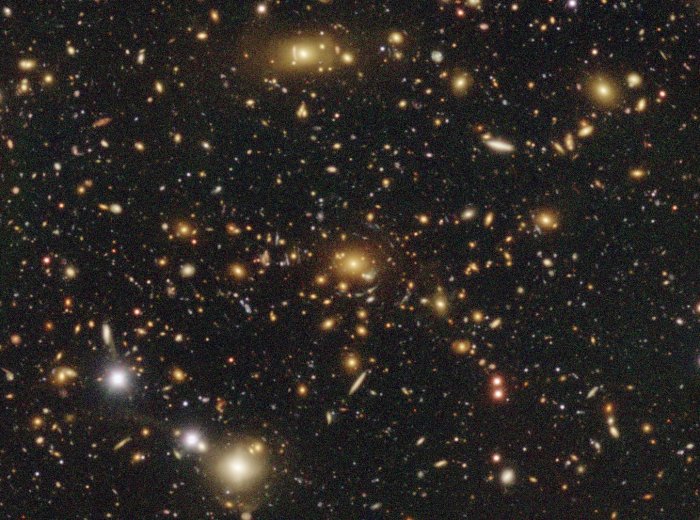Wide And Sharp 3D Dark Matter Map Created – Important Step To Better Understand Accelerating Expansion Of The Universe
MessageToEagle.com – A wide and sharp 3D dark matter map based on the recent imaging data by Hyper Suprime-Cam (HSC) on the Subaru Telescope has been released by an international team of astronomers including the National Astronomical Observatory of Japan and University of Tokyo.
The camera, called Hyper Suprime-Cam captures a wide area in the sky equivalent to the combined size of nine full moons in one shot.
Dark matter is the most mysterious building block of outer space and it is believed to form a fundamental part of our universe.

This is only 11 % of the planned final map, but it is already unprecedentedly wide. It is an important step to better understanding the Universe’s accelerating expansion.
The dark matter distribution is estimated by the weak gravitational lensing technique. The team located the positions and lensing signals of the dark matter halos and found indications that the number of halos could be inconsistent with what the simplest cosmological model suggests.
For now, this is the best and the sharpest dark matter map covering such a wide area. It covers a wider area and features a higher resolution than any other similar maps, according to researchers.
In the 1930’s, Edwin Hubble and his colleagues discovered the expansion of the Universe. A formula relating matter and the geometry of space-time was required in order to express the expansion of the Universe mathematically.
Coincidentally, Einstein had already developed just such a formula. Modern cosmology is based on Einstein’s theory for gravity.
Deeper understanding of the distribution of dark matter would help check the validity of the theory that the expansion of the universe is speeding up. Study on dark matter would also help understand better how galaxies and galaxy clusters have been formed.
Original story – here.
MessageToEagle.com
Related Posts
-
 LHS 3844b: Rocky, Earth-Sized Exoplanet Is Missing An Atmosphere
No Comments | Aug 21, 2019
LHS 3844b: Rocky, Earth-Sized Exoplanet Is Missing An Atmosphere
No Comments | Aug 21, 2019 -
 Black Hole Involved In Death Of An Exotic ‘Jellyfish’ Galaxy
No Comments | Jul 9, 2019
Black Hole Involved In Death Of An Exotic ‘Jellyfish’ Galaxy
No Comments | Jul 9, 2019 -
 New Satellites Of Milky Way: Sagittarius II, Reticulum II, Phoenix II, and Tucana III
No Comments | Oct 1, 2018
New Satellites Of Milky Way: Sagittarius II, Reticulum II, Phoenix II, and Tucana III
No Comments | Oct 1, 2018 -
 Black Hole Eruption Spanning 16 Times The Full Moon In The Sky – Captured
No Comments | Dec 23, 2021
Black Hole Eruption Spanning 16 Times The Full Moon In The Sky – Captured
No Comments | Dec 23, 2021 -
 Icarus: Most Distant Star, 9 Billion Light Years Away Found With Hubble’s Cosmic Lens
No Comments | Apr 3, 2018
Icarus: Most Distant Star, 9 Billion Light Years Away Found With Hubble’s Cosmic Lens
No Comments | Apr 3, 2018 -
 What Is ‘Oumuamua? An Asteroid, A Comet … Or An Alien Artifact?
No Comments | Dec 5, 2018
What Is ‘Oumuamua? An Asteroid, A Comet … Or An Alien Artifact?
No Comments | Dec 5, 2018 -
 New Study Reveals Some Of Ancient Secrets Of ‘Monster’ Star-Forming Galaxies
No Comments | Aug 30, 2018
New Study Reveals Some Of Ancient Secrets Of ‘Monster’ Star-Forming Galaxies
No Comments | Aug 30, 2018 -
 Delta Orionis in Orion’s Belt – A Complex And Fascinating Multiple Star System
No Comments | Nov 29, 2015
Delta Orionis in Orion’s Belt – A Complex And Fascinating Multiple Star System
No Comments | Nov 29, 2015 -
 Unique Metal-Rich Psyche Asteroid – Its First Temperature Map Obtained From Earth
No Comments | Aug 6, 2021
Unique Metal-Rich Psyche Asteroid – Its First Temperature Map Obtained From Earth
No Comments | Aug 6, 2021 -
 Surprise! Newfound Asteroid Is ‘Quasi-Moon’ of Earth
No Comments | Jun 18, 2016
Surprise! Newfound Asteroid Is ‘Quasi-Moon’ of Earth
No Comments | Jun 18, 2016
